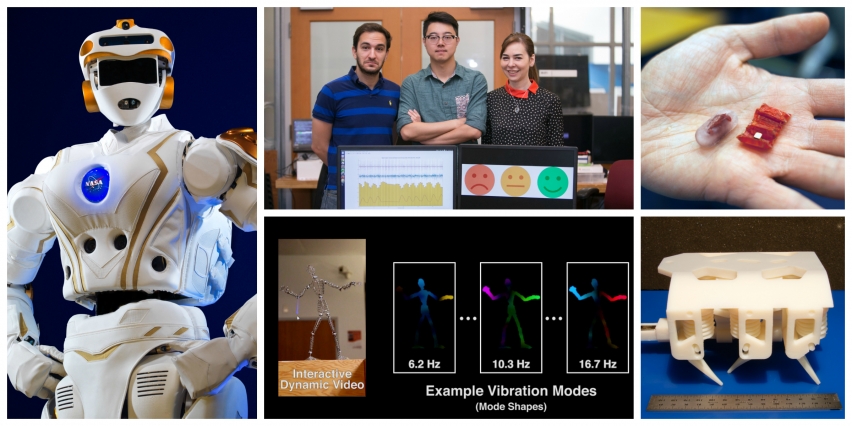
Robohub.org
Ingestible robots, glasses-free 3-D, and computers that explain themselves

In 2016, MIT CSAIL researchers worked on a range of projects in robotics, theory, wireless technology, software systems, and other disciplines. Image: CSAIL
Machines that predict the future, robots that patch wounds and wireless emotion-detectors are just a few of the exciting projects that came out of MIT’s Computer Science and Artificial Intelligence Laboratory (CSAIL) this year. Here’s a sampling of 16 highlights from 2016 that span the many computer science disciplines that make up CSAIL.
Robots for exploring Mars — and your stomach
- A team led by CSAIL director Daniela Rus developed an ingestible origami robot that unfolds in the stomach to patch wounds and remove swallowed batteries.
- Researchers are working on NASA’s humanoid robot, “Valkyrie,” who will be programmed for trips into outer space and to autonomously perform tasks.
- A 3-D printed robot was made of both solids and liquids and printed in one single step, with no assembly required.
Keeping data safe and secure
- CSAIL hosted a cyber summit that convened members of academia, industry, and government, including featured speakers Admiral Michael Rogers, director of the National Security Agency; and Andrew McCabe, deputy director of the Federal Bureau of Investigation.
- Researchers came up with a system for staying anonymous online that uses less bandwidth to transfer large files between anonymous users.
- A deep-learning system called AI2 was shown to be able to predict 85 percent of cyberattacks with the help of some human input.
Advancements in computer vision
- A new imaging technique called Interactive Dynamic Video lets you reach in and “touch” objects in videos using a normal camera.
- Researchers from CSAIL and Israel’s Weizmann Institute of Science produced a movie display called Cinema 3D that uses special lenses and mirrors to allow viewers to watch 3-D movies in a theater without having to wear those clunky 3-D glasses.
- A new deep-learning algorithm can predict human interactions more accurately than ever before, by training itself on footage from TV shows like “Desperate Housewives” and “The Office.”
- A group from MIT and Harvard University developed an algorithm that may help astronomers produce the first image of a black hole, stitching together telescope data to essentially turn the planet into one large telescope dish.
Tech to help with health
- A team produced a robot that can help schedule and assign tasks by learning from humans, in fields like medicine and the military.
- Researchers came up with an algorithm for identifying organs in fetal MRI scans to extensively evaluate prenatal health.
- A wireless device called EQ-Radio can tell if you’re excited, happy, angry, or sad, by measuring breathing and heart rhythms.
Algorithms, systems and networks
- A system called “Polaris” was found to load web pages 34 percent faster by decreasing network trips.
- A team analyzed ant-colony behavior to create better algorithms for network communication, for applications such as social networks and collective decision-making among robot swarms.
- Researchers trained neural networks to explain themselves by providing rationales for their decisions.
tags: algorithms, c-Research-Innovation, Computer Science and Artificial Intelligence Laboratory (CSAIL), Computer science and technology, computer vision, Electrical Engineering & Computer Science (eecs), Research, robotics, School of Engineering, wireless

CSAIL MIT
The Computer Science and Artificial Intelligence Laboratory – known as CSAIL – is the largest research laboratory at MIT and one of the world’s most important centers of information technology research.

CSAIL MIT
The Computer Science and Artificial Intelligence Laboratory – known as CSAIL – is the largest research laboratory at MIT and one of the world’s most important centers of information technology research.
Related posts :
Interview with Zahra Ghorrati: developing frameworks for human activity recognition using wearable sensors
Lucy Smith and AIhub
08 Oct 2025
Zahra tells us more about her research on wearable technology.
Women in robotics you need to know about 2025
Women In Robotics
06 Oct 2025
This global list celebrates women's impact across the robotics ecosystem and globe.
Robot Talk Episode 127 – Robots exploring other planets, with Frances Zhu
Robot Talk
03 Oct 2025
In the latest episode of the Robot Talk podcast, Claire chatted to Frances Zhu from the Colorado School of Mines about intelligent robotic systems for space exploration.
Mars rovers serve as scientists’ eyes and ears from millions of miles away – here are the tools Perseverance used to spot a potential sign of anci
The Conversation
02 Oct 2025
How do scientists engage with rover data and use robots such as Perseverance?
Rethinking how robots move: Light and AI drive precise motion in soft robotic arm
Rice University
01 Oct 2025
Researchers at Rice University have developed a soft robotic arm capable of performing complex tasks.
RoboCup Logistics League: an interview with Alexander Ferrein, Till Hofmann and Wataru Uemura
AIhub and Lucy Smith
25 Sep 2025
Find out more about the RoboCup league focused on production logistics and the planning.
Drones and Droids: a co-operative strategy game
Phil Peterson
22 Sep 2025
Scottish Association for Marine Science is running a crowdfunding campaign for educational card game.
Call for AAAI educational AI videos
AIhub
22 Sep 2025
Submit your contributions by 30 November 2025.


